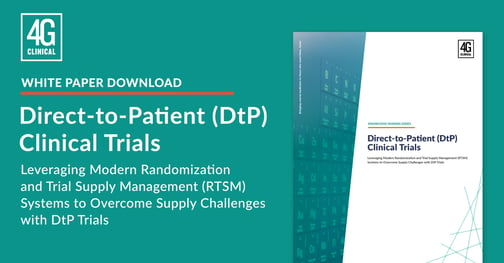March 19, 2020
Is Now The Right Time To Switch To Direct-to-Patient (DtP) Trials?
Written by: 4G Clinical
COVID-19 is officially a global pandemic. The healthcare community is swiftly working to create a vaccine, which involves enrolling patients into a clinical trial when there may be fear getting to a clinical setting.
In the midst of this outbreak, there are countless other immunocompromised individuals traveling to clinical sites to participate in trials globally across all therapeutic areas. As an industry, it is our responsibility to be proactive in planning/adjusting our clinical trials to allow patients to safely participate and move research forward.
You have probably considered it before, and now it may be exactly the right time to transition to a Direct-to-Patient (a type of decentralized clinical trial or DCT) approach. It is important to note that DtP trials are not virtual or siteless trials. The clinical research site still plays an important role in the process, but this model enables the patient to receive medication at home rather than traveling to the clinical site for each and every visit.
DtP trials must be carefully planned into the study protocol. There are regulations, requirements and complications to consider in the design, and many more stakeholders. Here are five questions you should ask yourself when planning a DtP trial.
1. Which DtP approach makes the most sense for my study?
There are three main types of DtP Models: Depot-to-Patient, Site-to-Patient and Hybrid.
With Depot-to-Patient, the IMP is shipped directly from the main or sub depot (e.g., central pharmacy) to the patient home. Nurse services may be added. With Site-to-Patient, the IMP is shipped from the depot to the site, and from the site to the patient home. The most utilized approach is Hybrid, which is a mix of DtP/traditional site visits. In other words, when patients have site visit(s) and also receive IMP at home (from depot or site) in other visits. Hybrid is the most patient-centric approach.
2. Who is responsible to ensure that coordination between the courier and patient (and potentially the pharmacist, nurse services)? What is the role of the sponsor? The courier, site and depot?
Shipping coordination and logistics is one of the main supply risks of DtP trials. Unlike traditional trials, with DtP the courier is patient-facing which introduces challenges with delivery. The arrival window is only 2–3 hours vs. site opening hours. The process for ensuring drug product arrives on time, the patient is home, etc., requires detailed coordination and alignment from all stakeholders on who is responsible for what portion of the process.
3. How would you ensure patient privacy when the drug is sent to the patient’s home?
Traditional trials are designed in a way to protect patient privacy. When shipping drug directly to patients, there must be a record of patient names and addresses. Therefore, this introduces a risk of unblinding or bias. The questions remains, should the RTSM house patient names and addresses or should this data remain with the CMO/courier to coordinate the process?
4. What tools/technology is available to streamline the process?
RTSM (Randomization and Trial Supply Management) systems play a critical role in ensuring the right medication gets to the right patient at the right time. Leveraging an RTSM can enable DtP trials, mitigating risks with shipping coordination/cancellations, temperature excursions as well as accountability, returns and destruction.
5. What steps should you take if you want to start or transition to a DtP trial?
Once you have decided what approach works best for your study, you will want to map out the process for virtual dispensing including all the critical decisions points, involvement of different stakeholders (depot, courier, patient, etc.) for all potential outcomes. Decisions will need to be made on logistics and tracking, including the use of RTSM to manage resupply, temperature excursions, etc. Once the process is outlined, it is critical to gain buy-in of all stakeholders involved in the process to ensure each and every time a shipment is raised the process remains consistent. A protocol amendment will need to be submitted describing the new process, the informed consent will need to be updated and all roles involved will need to be re-trained on the new process. Additional steps may be added depending on the study design and unique parameters of the drug supplied.
At 4G Clinical, we are committed to making an impact on the way trials are executed and to do our part in bringing crucial medicines to those who need them, faster. Our RTSM experts are available to assist you in planning your next DtP trial.
For additional resources, please download our white paper:
Tag(s):
Study Execution

